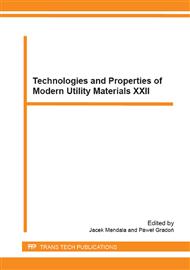p.173
p.177
p.185
p.189
p.193
p.199
p.205
p.209
p.215
The Use of Trapezoidal Fuzzy Numbers in the Model to Optimize the Batch of Electric Arc Furnace
Abstract:
The classical models to optimize the batch of electric arc furnace require precise and predetermined numerical values. In order to determine the scrap steel properties (eg. chemical composition), we are not able to define these values precisely and accurately. This situation is due to the heterogeneity and specificity of this material, which is related to its origin and way of obtaining. Therefore the usefulness of classical models to optimize the batch of electric arc furnace is limited. The fuzzy numbers with trapezoidal membership function were applied as a model in order to describe the technological process of steelmaking, which is neither accurate nor of ambiguous nature of the parameters. The advantage of trapezoidal numbers is a simple algorithm of arithmetic operations as well as easy and intuitive interpretation. The structure of optimization model with fuzzy parameters is similar to the classical linear optimization model of the mixtures composition. The optimization model, that is formulated on the fuzzy ranges arithmetic principles, allows to ensure that the quality parameters of the batch mix for the electric arc furnace are as precise as the ones described by electro-steel works, even though the quality parameters of scrap steel as well as some of the parameters of steel melting technological process are described ambiguously.
Info:
Periodical:
Pages:
199-204
Citation:
Online since:
January 2015
Authors:
Price:
Сopyright:
© 2015 Trans Tech Publications Ltd. All Rights Reserved
Share:
Citation:


